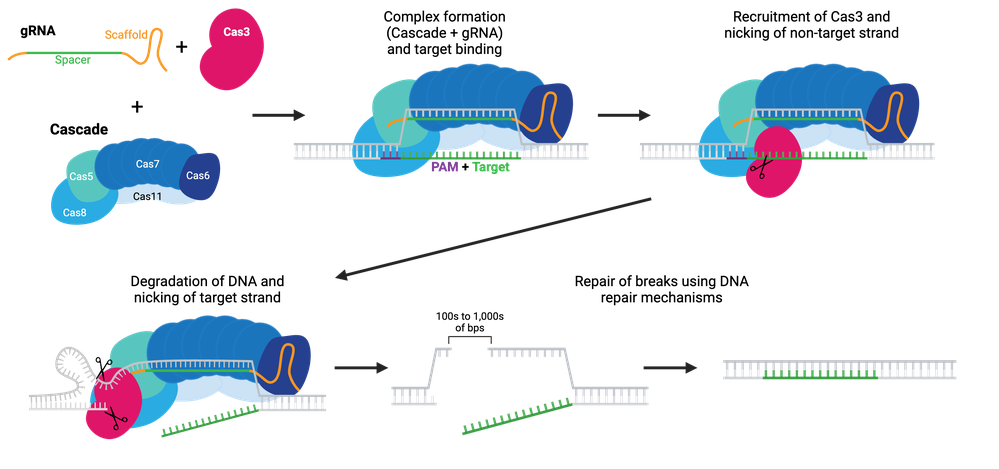CRISPR Plasmids: Cascade-Cas3
Cas3 is a unique member of the CRISPR family. After nicking the target DNA, Cas3 initiates single-strand DNA degradation. This degradation can continue for many kilobases in one or both directions from the target region, effectively turning Cas3 into a DNA “shredder” system that can cause large genomic deletions. Compared to deletions generated by Cas9, large deletions created using Cas3 have fewer off-target alterations and require only a single gRNA.
Cas3 must be paired with the Cascade (CRISPR-associated complex for antiviral defense) complex, comprised of a combination of Cas5, Cas6, Cas7, Cas8, and Cas11. Cascade is directed to target DNA using a gRNA and recruits Cas3. After nicking the non-targeted strand, Cas3 starts unraveling DNA using its helicase properties, cleaving the targeted strand non-specifically along the way. Cas3 initiates a final double-strand break, either due to a boundary defined by anti-CRISPR proteins or running into other proteins bound to DNA, and the break can be repaired by the cell’s endogenous repair mechanisms.
Cas3 belongs to the Class 1 family of CRISPR systems, the most abundant type found in bacteria and archaea. While abundant in nature, Class 1 systems are largely underutilized compared to their Class 2 counterparts like Cas9. This is attributed in part to the difficulties in getting all components of the Cascade complex to express equally. To combat this, some CRISPR-Cas3 plasmids take an all-in-one approach and include Cas3 and Cascade on one single plasmid, though many still separate the individual Cas components.

Plasmids are available for expression in mammalian systems, bacteria, and plants.
Mammalian
| ID | Plasmid | Gene/Insert | Promoter | PI | Publication |
|---|
Bacteria
| ID | Plasmid | Gene/Insert | Promoter | PI | Publication |
|---|
Plant
| ID | Plasmid | Gene/Insert | Promoter | PI | Publication |
|---|
Last reviewed on: January 30, 2025

Do you have suggestions for other plasmids that should be added to this list?
Fill out our Suggest a Plasmid form or e-mail [email protected] to help us improve this resource!
